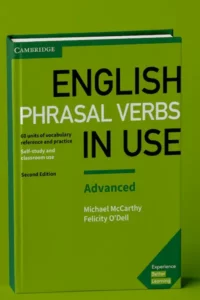English Phrasal Verbs in Use Advanced will Improve your understanding of phrasal verbs in English and provide you with explanations and practice of approximately 1,000 phrasal verbs for the advanced level.
Also Read: English Verbs
English Phrasal Verbs in Use Advanced
The English Phrasal Verbs in Use Advanced book has 60 two-page units. The left-hand page explains the phrasal verbs that are presented in the unit. You will usually find an explanation of the meaning of the phrasal verb, an example of it in use, and, where appropriate, some comments on when and how it is used. The exercises on the right-hand page check that you have understood the information on the left-hand page and give you practice in using the material presented.
The units are organized into different sections.
First, we start with important information about phrasal verbs in general (Units 1–4): what they are, how their grammar works, and so on. We strongly recommend that you do these units first.
Why was this book written?
It was written to help you take your knowledge of phrasal verbs to a more advanced level. It is intended for students who already have at least an upper intermediate level of English. Many of you will have already worked with English Phrasal Verbs in Use Intermediate and this book builds on the work done there.
However, it does not matter if you have gained your knowledge of phrasal verbs in a different way. We do not assume that you have used English Phrasal Verbs in Use Intermediate, although we do present and practise either different phrasal verbs in this book or, occasionally, more advanced uses of verbs that were presented in the lower-level book.
How were the phrasal verbs in this book selected?
The approximately 1,000 phrasal verbs and related nouns and adjectives which are presented in this book were all selected from those identified as significant by the CAN CODE corpus of spoken English developed at the University of Nottingham in association with Cambridge University Press, and the Cambridge International Corpus of written and spoken English.
The phrasal verbs selected are accordingly also to be found in the Cambridge Phrasal Verbs Dictionary, where you can find additional usage notes and examples.
How is the book organized?
The book has 60 two-page units. The left-hand page explains the phrasal verbs that are presented in the unit. You will usually find an explanation of the meaning of the phrasal verb, an example of it in use and, where appropriate, some comments on when and how it is used. The exercises on the right-hand page check that you have understood the information on the left-hand page and give you practice in using the material presented.
The units are organized into different sections.
- First, we start with important information about phrasal verbs in general (Units 1-4): what they are, how their grammar works, and so on. We strongly recommend that you do these units first.
- The next section looks at some interesting aspects of more advanced phrasal verbs, dealing with such important issues as collocation, register, and metaphor. As these are themes that are returned to throughout the book, it is a good idea to work through these units before progressing to other more specific units.
- After these two introductory sections, there is a section dealing with some of the most common particles used in forming phrasal verbs. Working on these units will help you to gain a feeling for the force of these particles and will help you have a feeling for the meaning of a phrasal verb you are meeting for the first time.
- The next two sections deal with Concepts (e.g. Change) and Functions (e.g. Arranging things). These sections are followed by a large number of topic-based units focusing on different aspects of Work, Personal life, and The world around us.
- The final section looks at some of the most common verbs which are used to form phrasal verbs.
The book has a key to all the exercises so that you can check your answers. At the back of the book you will also find a useful Mini dictionary. This provides clear definitions of all the phrasal verbs and related noun and adjective forms that appear in this book. The Mini dictionary also indicates the unit number where you can find a particular phrasal verb.
Also Read: English Idioms in Use Advanced
How should I use this book?
It is strongly recommended that you work through Units 1-4 first so that you become familiar with the way phrasal verbs (and their associated nouns and adjectives) operate and with the terminology that is used in the rest of the book. Then we suggest that you move on to Units 5-9 and after that, you may work on the units in any order that suits you.
What else do I need in order to work with this book?
You need a notebook or file so that you can write down the phrasal verbs that you study in the book as well as any others that you come across elsewhere. You also need to have access to a good dictionary. We strongly recommend the Cambridge Phrasal Verbs Dictionary as this gives you exactly the kind of information that you need to have about phrasal verbs.
Your teacher, however, may also be able to recommend other dictionaries that you may find useful. So all that remains is to say Go for it! (Unit 31). We hope you’ll find this an enjoyable as well as a useful way to keep up and extend your knowledge of English phrasal verbs in use.
Also Read: All Cambridge IELTS Books

